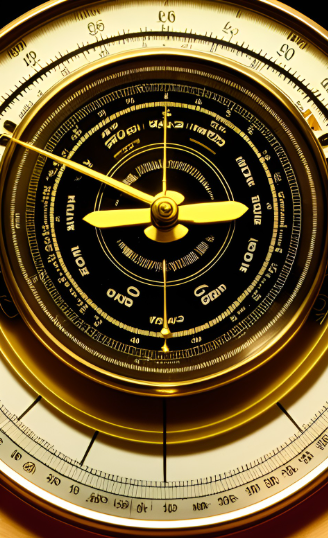Barometric pressure definition - How it shapes weather
A good barometric pressure definition lets you figure out what that means and how important it is. You'd know how hard the air presses on us. The barometric pressure is the atmospheric pressure at a given point. Weather patterns can be affected by it because it affects air flow. Low pressure systems bring more turbulent weather, while high pressure systems bring calmer weather. Forecasting weather requires an understanding of barometric pressure.
Find more about measurements.
Barometric pressure and weather: The Invisible Hug - Every sunny day and sudden storm is controlled by an invisible pressure that presses down on us like a house? Learn what units like millibars mean and how a simple drop in that pressure is the first sign of turbulent weather.
The barometric pressure is like the Earth's invisible hug. It tells us how hard the air is pressing down. Low pressure means storms, and high pressure means nice weather. As you climb up a mountain, the air pressure drops, but not constantly. At first, it gets weaker faster, then it slows down.
It's measured in different units, like PSI and Pascals, and even meteorologists like millibars. For weather forecasts, it's essential.
Take a look at your roof: It's powerful enough to crush things, but it doesn't because the air underneath pushes back. It's like peer pressure, but for the air, and even affects your car's tires! It's like a secret code that helps us understand weather and how things work.
Cool, right?
Under Pressure
As you go up in altitude , the pressure drops. Is it sudden? For every 50,000 feet, or about 15 km, you go up, the pressure drops by around 90%. There's no constant rate of pressure decrease. As you go up in altitude, the pressure drops faster. As you go up, the rate of decrease slows down, so it's not a sudden drop.
Most people define air pressure in inches of mercury supported, mm of mercury (used for blood pressure), or force per unit area. Because these units are easy to measure, you can compare pressures between different places and atmospheres. Additionally, they provide a standard way to measure air pressure around the world.
Barometric pressure is measured in PSI, pounds per square inch, and Pascals, which are Newtons per square metre. Newtons are about a quarter pound. PSI is the most common unit of measurement for barometric pressure, since it's easy to understand. Scientific studies use Pascals because they're more precise.
Scientists have named Pascals and Newtons after dead guys, like the one at the top of this page.
Meteorologists like millibars, ever so odd. Here's another definition of barometric pressure: A
millibar is 100 Newtons per square metre; they are also known as hectaPascals. It's because millibars provide the most convenient representation of air pressure, which is important for weather forecasts. In addition, they're a standard unit of air pressure, so meteorologists use them.
Standard pressure
The atmosphere is also a unit of normal barometric pressure. It's equal to sea-level atmospheric pressure. It's 101,325 Pa, but the International Union of Pure and Applied Chemistry prefers round numbers, so they call it 100,000 Pa, or 100 kPa. Because of weather patterns and location, real atmospheric pressure varies.
What's the air weight on the roof of your house? In a 1000 square foot house for instance, the pressure on top is 1000 x 14.7 x 12 x 12 or almost 10 MN (per thousand square feet). That's enough to flatten any building.
Your roof doesn't cave in because the underside has the same air pressure pushing it up. Depending on your elevation and weather, you'll get different values.
A few barometric pressure definitions
According to the dictionary.
Pressure:
1) Weight, steady force against something. In physics, we divide the force by the area to get its distribution. Pascals are Newtons over a square meter, for example. This kind of pressure is easy to measure quantitatively.
2) Work pressure. time and effort are needed for urgent stuff.
3) Peer pressure - the pressure to conform to social norms. You can also use this to make someone do something.
4) Blood Pressure, - the pressure of the blood against the inner walls of the arteries, or blood pressure. It's usually only an issue if it's too high. Let's say 140 over 90 mm of mercury.
Here's another useful physics concept. An ambient pressure over a fixed area is directly proportional to force per unit area.
Since liquid is flexible, a tube of constant diameter filled with liquid works great. The earth's atmospheric pressure can hold up about 32 feet of water if you use it. It's hard to fit a 32 foot tube vertically in a lab, so it's more practical to use mercury instead, which is 13.6 times denser than water. Three feet is more than enough, since atmospheric pressure normally supports two and a half feet, or 760 millimetres.
Using the barometric pressure definition above, we put about 30 to 50 PSI into our tires.
What is the pressure at the bottom of the ocean?
Using our previously mentioned barometric pressure definition, every 10 meters you go down in the water adds an atmosphere's force. As a result, the surrounding hydrostatic pressure goes up. Water in the ocean can be 10,000 meters deep, so it's 1000 times as dense as air at sea level, or about 15000 pounds per square inch.
How about the center of the earth? Estimates vary, but it's at least 3.5 million atmospheres or 350 GPa. About a thousand million to over 300 thousand million atmospheres are estimated for the sun's center.
Go back from Barometric Pressure Definition to the Weather Equipment web page or visit the Stuff in the Air homepage.
Search this site for more information now.
What is barometric pressure? How much air is above you?
Barometric pressure definition and description, units of normal barometric pressure made in the air and other types of pressure to compare it with.
Do you have concerns about air pollution in your area??
Perhaps modelling air pollution will provide the answers to your question.
That is what I do on a full-time basis. Find out if it is necessary for your project.
Have your Say...
on the StuffintheAir facebook page
Other topics listed in these guides:
The Stuff-in-the-Air Site Map
And,
Thank you to my research and writing assistants, ChatGPT and WordTune, as well as Wombo and others for the images.
OpenAI's large-scale language generation model (and others provided by Google and Meta), helped generate this text. As soon as draft language is generated, the author reviews, edits, and revises it to their own liking and is responsible for the content.






New! Comments
Do you like what you see here? Please let us know in the box below.